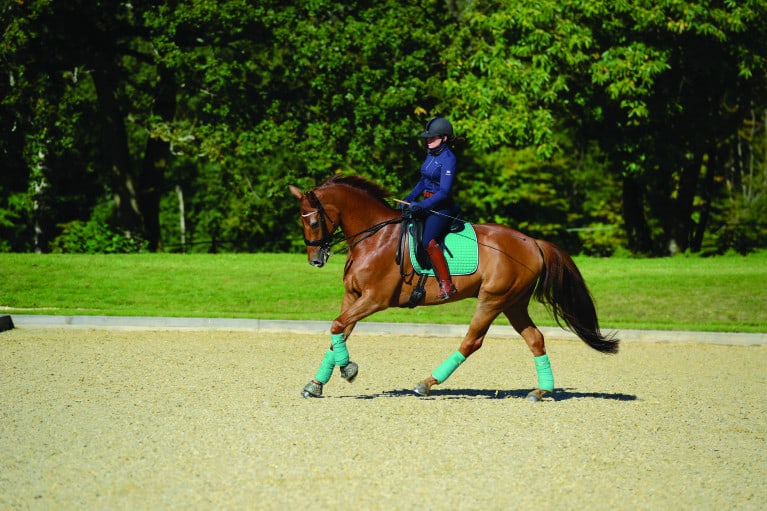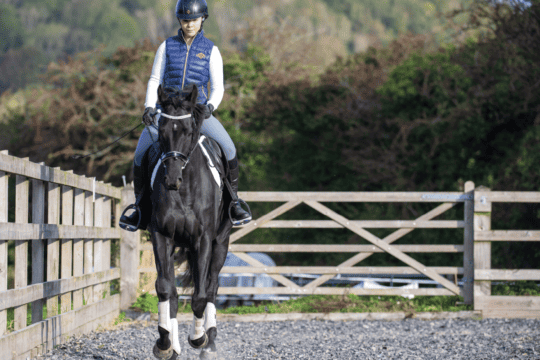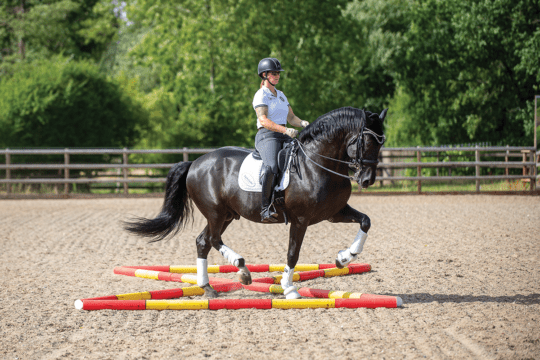We’ve put together a collection of the most common dressage terms, and had it all checked over by one of the top dressage judges in the world. So you know you can trust it!

Dressage Terminology
Contact Refers to the consistent connection the rider has on the horse’s mouth through the reins and which the horse should accept at all times. There should be no resistance, no open mouth and no grinding of the teeth. It’s the rider’s job to make sure that the contact remains consistent and ‘elastic’, which is achieved through the rider having an independent seat and the horse accepting the rider’s leg aids to go forward. As the horse becomes ‘submissive’ in his mouth to provide that soft, elastic contact, the rider should then feel a ‘yielding’ to pressure of the bit. And this is achieved by a squeeze-and-release action of the rider’s fingers on the reins. By achieving the correct contact, the horse should be able to find his balance under the rider, together with a steady rhythm in walk, trot and canter.
Engagement Is the connection between the horse’s hind legs and the rein. It is achieved by the forward movement coming from an active hind leg into a consistent, elastic rein contact. The horse should be encouraged to move forward freely, energetically and rhythmically to the rein and must not be held in an outline. To help your horse achieve engagment, he must be supple and flexible through his back, and lateral exercises should help this. And transitions are good for developing balance and self-carriage and, therefore, engagement of the hindquarters.
Flying change This is performed to change direction. For example, as the rider asks the horse to canter on the right lead, she moves her left leg back behind the girth to ask the horse to change leg while in the suspension phase.
Half-pass The horse moves forward and sideways at the same time, flexed in the direction of travel. It is simply quarters in (travers) ridden across a diagonal.
To ride half-pass, flex the inside rein and bend the horse in the direction of travel, using the outside rein to control the amount of bend. Keep your outside leg slightly behind the girth to push the quarters sideways and remember, the forehand (shoulder) should lead slightly. Your inside leg should stay in the ‘normal’ position, guarding the forehand and pushing the horse forward – it also encourages the hind leg to step under the horse, to produce engagement of the back end. Move your weight slightly in the direction of travel.
Leg-yield This is where the horse moves forward and sideways – ie, usually from the centre of the threequarter line towards the outside track – slightly bent and flexed away from the direction in which he is travelling. The horse’s body should be straight, but with a slight flexion (bend) at the poll, so that the rider can just see the horse’s nostril. The horse’s inside front and hindlegs should pass and cross in front of the outside legs. Leg-yield is a great way of teaching the horse to move sideways off the leg and should be practised on both reins to achieve equal balance.
To ride leg-yield, take the inside leg slightly back and apply pressure to encourage the horse to step sideways. The outside leg is used to push the horse forward and stop the hind legs from leading the movement. The inside rein flexes the horse, while the outside rein controls the flexion. And the rider’s weight should stay in the middle of the horse, but should move into the direction of travel.
On and back (shortening and lengthening for a few strides) is good for improving elasticity and ground cover in the paces. You simply ride a few medium strides, then bring your horse back to a more collected pace to establish engagement. However, the difference between the collected pace and the medium pace must be dramatic with your horse surging forward out of the transition.
Passage This is very collected trot.
Piaffe Very collected trot on the spot.
Pirouette The horse is turned through 360 degrees – in walk, canter or piaffe – by pivoting around the inside hindleg.
Put the horse up together Work through from behind from an engaged hind leg into a steady rein contact.
Shoulder-fore This is an exercise often used to straighten the horse in canter. The shoulders are very slightly positioned onto an inside track, with the horse being very slightly bent away from the direction he is travelling.
Shoulder-in As shoulder-fore, but the forehand is brought in from the track to an angle of about 30 degrees with the footfalls forming three distinct tracks (outside hind on the outside track, inside hind and outside fore on the middle, inside fore on a third inside track), with the horse adopting a clean and uniformed bend from nose to tail away from the direction he is travelling. Shoulder-in is the foundation of all lateral work. Not only is it good for encouraging straightness, but it’s also a good suppling exercise and a great collecting movement.
To ride shoulder-in, make a 10-metre circle in the corner of the long side of the arena, to encourage the correct bend. On the long side, bring the horse’s forehand (shoulder) off the track, as if you were going to ride another circle. When the shoulders and forelegs leave the track, control the degree of bend to othe inside by keeping a contact on the outside rein. Your inside leg should remain at the girth, maintaining impulsion and encouraging the forward and sideways movement. Keep your outside leg behind the girth, to prevent the hindquartrs from swinging out. Sit centrally and look between the horse’s ears, keeping your shoulder in line with your horse’s shoulder.
Straight A horse is said to be ‘straight’ when his forehand (shoulder) is in line with his hindquarters and he is using both hind legs equally. This then helps ensure that the horse’s weight is balanced over the front and back end of his body. It is developed by consistently working both sides of the body equally – ie, on both reins. This is important as most horses are crooked, in that they have a strong and a weak side, much the same as we are right or left-handed.
Suppleness This term is applied when a horse is able to work through his back without any signs of tension in the muscles. In fact, he should be physically and mentally free of all tension, so that he can apply himself fully to the task in hand. When you school your horse, you can tell if he is loose and relaxed by the contented, happy (hopefully!) expression on his face, the tell-tale signs being the eyes and ears. And do his back and tail – which should be slightly lifted – swing rhythmically in time with the movement of his back? Is his mouth closed (he can, however, ‘mouth’ the bit gently)? And can he stretch his neck forward and down in walk, trot and canter? If he can – and he’s showing all of these signs – then you’ve cracked it! And don’t worry about any soft ‘snorting’, as that’s also a sign that your horse is mentally relaxed.
Throughness Means encouraging your horse to accept the aids willingly and without any tension. It is the term used to describe the energy coming from the hindquarters working ‘through’ a supple and swinging back into an accepting and elastic contact with the bit, which allows the horse to develop elasticity and cadence within the paces.
Travers The horse is flexed in the direction of travel. The forehand (shoulder) stays on the outside track, the hindquarters on the inside. Travers is a good suppling and straightening exercise. It is best performed along the wall or fence line of the school, or on the centre line at an angle of 30 degrees to the direction in which the horse is travelling. The wall (or fence line) helps the rider control and maintain the angle of the bend.
Also known as ‘quarters in’, ride the movement by flexing the inside rein and bending the horse in the direction of travel, using the outside rein to control the amount of flexion and bend. Keep your outside leg slightly behind the girth to bring the quarters onto an inner track. Your inside leg should stay in the ‘normal’ position, guarding the horse’s forehand (shoulder) and pushing the horse forward. Your inside leg also encourages the hind leg to step under the horse, to encourage engagement of the back end. Move your weight very slightly in the direction of travel.
True way of going In balance and with self-carriage, with no leaning on the rein.
Turn-on-the-forehand This helps a horse’s obedience to the sideways pushing aids. In this, the horse’s hindquarters move around the inside foreleg. You must have a good walk rhythm to start with, with the horse bent in the direction away from the movement of the hindquarters. Therefore, he bends to the right if the quarters are pushed to the left. He must also cross his hind legs while stepping with his front legs almost on the same spot.
Your Comments
2 thoughts on “Dressage terminology glossary”
Leave a Reply
You must be logged in to post a comment.
















Would also like to know what the following phrases mean:
Behind the bit;
Outside rein;
Low and closed; and,
Chewing the reins from the hand
What does ‘off the bridle ‘ mean?!